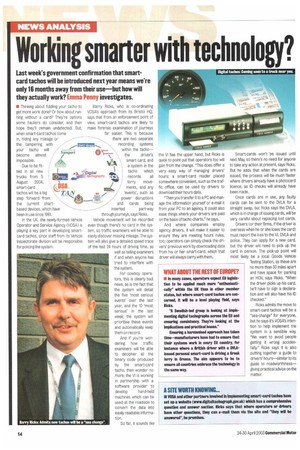Working smarter with technology? •
Page 14

If you've noticed an error in this article please click here to report it so we can fix it.
Last week's government confirmation that smart card tachos will be introduced next year means we're only 16 months away from their use—but how will they actually work? Emma Penny investigates.
IN Thinking about fiddling your tacho to get more work done? Or how about running without a card? They're options some hauliers do consider, and then hope they'll remain undetected. But, when smart-card tachos come
in, hiding any mileage or the tampering with your tacho will become almost impossible.
Due to be fitted in all new trucks from 5 August 2004, smart-card tachos will be a big step forward from the current chartbased devices, which have been in use since 1981.
In the UK, the newly-formed Vehicle Operator and Service Agency (VOSA) is playing a key part in developing smartcard tachos, since staff from its Vehicle Inspectorate division will be responsible for policing the system. Barry Ricks, who is co-ordinating VOSA's approach from its Bristol Hp, says that from an enforcement point of view, smart-card tachos are likely to make forensic examination of journeys far easier. This is because there are two separate recording systems \ within the tacho the driver's
itA I smart card, and
a system in the tacho which records all lorry movements, and any 'events', such as power disruptions • 1,7 and cards being inserted part-way through journeys, says Ricks. Vehicle movement will be recorded even though there's no card in the system, so traffic examiners will be able to easily discover missing mileage. The system will also give a detailed speed trace of the last 24 hours of driving time, as well as telling examiners if and when anyone has tried to interfere with the system.
For cowboy operators, this is clearly bad news, as is the fact that the system will detail the five 'most serious events' over the last year, and the 10 'most serious' in the last week; the system will prioritise these events and automatically keep them on record.
And if you're wondering how traffic examiners will be able to decipher all the binary code produced by the smart-card tacho, then wonder no more; the VI is working in partnership with a software provider to develop hand-held machines which can be used at the roadside to convert the data into easily readable information.
So far, it sounds like the VI has the upper hand, but Ricks is quick to point out that operators too will gain from the change. "This does offer a very easy way of managing drivers' hours: a smart-card reader placed somewhere convenient, such as the traffic office, can be used by drivers to download their hours data.
"Then you transfer it to a PC and manage the information yourself Or e-mail it from your PC to an agency. It could also ease things where your drivers are paid on the basis of tacho charts," he says.
And where companies employ agency drivers, it will make it easier to ensure they are meeting hours rules, too; operators can simply check the drivers' previous work by downloading data from his or her smart-card, which that driver will always carry with them. Smart-cards won't be issued until next May, so there's no need for anyone to take any action at present, says Ricks. But he adds that when the cards are issued, the process will be much faster where drivers already have a photocard licence, as ID checks will already have been made.
Once cards are in use, any faulty cards can be sent to the DVLA for a straight swap, but Ricks says the DVLA, which is in charge of issuing cards, will be very careful about replacing lost cards.
Drivers (or their firms, if the driver is overseas when he or she loses the card) must report the loss to the VI, DVLA and police. They can apply for a new card, but the driver will need to pick up the card in person. The pick-up point will most likely be a local Goods Vehicle Testing Station, as these are no more than 30 miles apart and have space for parking an HGV, says Ricks. "When the driver picks up his card, he'll have to sign a declaration and will also have his ID checked."
Ricks admits the move to smart-card tachos will be a "sea-change" for everyone, but he says it's VOSA's intention to help implement the system in a sensible way. Ine want to avoid people getting it wrong accidentally." Ricks says it is also putting together a guide to drivers' hours—similar to its guide to roadworthiness— giving practical advice on the matter.
































































































































































